Button Cell Batteries
Stage of development/applications
- Used to power small portable electronics devices, for example hearing aids, wrist watches, pocket calculators, toys, automobile keyless entry transmitters
Components
- Button cell batteries may be comprised of different materials depending on the application.
- There are four chemistry types of button cell batteries: alkaline, lithium and silver oxide, and mercury (no longer produced)
- Possible materials include: zinc, lithium, mercury, manganese dioxide, silver oxide, carbon monofluoride, cupric oxide or oxygen from the air.
Risks/hazards
Refer to our Button Battery: Guidelines for Safe Use and Disposal for more information.

In the top row of the photo below you will see some examples of button cell batteries. The terminals of a button cell battery are the flat sides, so they cannot touch each other if they are part of a single battery, but if stored together with other metal objects or other button cell batteries, there is a risk of short circuit. The second and third rows shows the process of taping them on both sides to reduce the risk of swallowing and to minimise the risk that they might short circuit.
Storage of used button cell batteries

Disposal and recyclability
It is important not to store used button cell batteries in the home because of the very serious risk they pose to small children. The best thing is to do is tape them as soon as they become loose and dispose of them at the first opportunity. It is preferable to take them to a recycler as button cells batteries are highly recyclable, but if you do not have access to a recycler, the next best thing is to put them in the rubbish. This only make sense if you have a small number, if you have a larger number, it is more important to tape them and find a recycler near you.
Collection rate
- No data
Recycling rate
- No Data
Label
- Depends on chemistry type
UN Number
- Depends on chemistry type
- Lithium: 3090
- Mercury: 1641
- Alkaline: 2795



